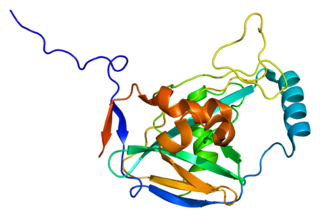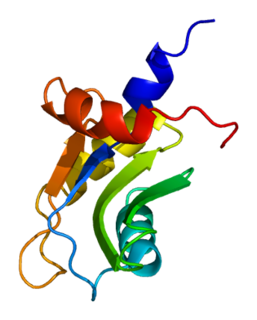Related Research Articles
Polyadenylation is the addition of a poly(A) tail to an RNA transcript, typically a messenger RNA (mRNA). The poly(A) tail consists of multiple adenosine monophosphates; in other words, it is a stretch of RNA that has only adenine bases. In eukaryotes, polyadenylation is part of the process that produces mature mRNA for translation. In many bacteria, the poly(A) tail promotes degradation of the mRNA. It, therefore, forms part of the larger process of gene expression.
Post-transcriptional modification or co-transcriptional modification is a set of biological processes common to most eukaryotic cells by which an RNA primary transcript is chemically altered following transcription from a gene to produce a mature, functional RNA molecule that can then leave the nucleus and perform any of a variety of different functions in the cell. There are many types of post-transcriptional modifications achieved through a diverse class of molecular mechanisms.
Cleavage and polyadenylation specificity factor (CPSF) is involved in the cleavage of the 3' signaling region from a newly synthesized pre-messenger RNA (pre-mRNA) molecule in the process of gene transcription. It is the first protein to bind to the signaling region near the cleavage site of the pre-mRNA, to which the poly(A) tail will be added by polynucleotide adenylyltransferase. The upstream signaling region has the canonical nucleotide sequence AAUAAA, which is highly conserved across the vast majority of pre-mRNAs. A second downstream signaling region, located on the portion of the pre-mRNA that is cleaved before polyadenylation, consists of a GU-rich region required for efficient processing.
Cleavage factors are two closely associated protein complexes involved in the cleavage of the 3' untranslated region of a newly synthesized pre-messenger RNA (mRNA) molecule in the process of gene transcription. The cleavage is the first step in adding a polyadenine tail to the pre-mRNA, which is one of the necessary post-transcriptional modifications necessary for producing a mature mRNA molecule.

Eukaryotic transcription is the elaborate process that eukaryotic cells use to copy genetic information stored in DNA into units of transportable complementary RNA replica. Gene transcription occurs in both eukaryotic and prokaryotic cells. Unlike prokaryotic RNA polymerase that initiates the transcription of all different types of RNA, RNA polymerase in eukaryotes comes in three variations, each translating a different type of gene. A eukaryotic cell has a nucleus that separates the processes of transcription and translation. Eukaryotic transcription occurs within the nucleus where DNA is packaged into nucleosomes and higher order chromatin structures. The complexity of the eukaryotic genome necessitates a great variety and complexity of gene expression control.

In enzymology, a polynucleotide adenylyltransferase is an enzyme that catalyzes the chemical reaction

Insulin-like growth factor-binding protein 7 is a protein that in humans is encoded by the IGFBP7 gene. The major function of the protein is the regulation of availability of insulin-like growth factors (IGFs) in tissue as well as in modulating IGF binding to its receptors. IGFBP7 binds to IGF with high affinity. It also stimulates cell adhesion. The protein is implicated in some cancers.

Cleavage stimulation factor 64 kDa subunit is a protein that in humans is encoded by the CSTF2 gene.

Cleavage and polyadenylation specificity factor subunit 5 (CPSF5) is an enzyme that in humans is encoded by the NUDT21 gene. It belongs to the Nudix family of hydrolases.

Cleavage and polyadenylation specificity factor subunit 2 is a protein that in humans is encoded by the CPSF2 gene.

Cleavage and polyadenylation specificity factor subunit 1 is a protein that in humans is encoded by the CPSF1 gene.

Poly(A) polymerase alpha is an enzyme that in humans is encoded by the PAPOLA gene.

Cleavage stimulation factor 50 kDa subunit is a protein that in humans is encoded by the CSTF1 gene.

Cleavage stimulation factor 77 kDa subunit is a protein that in humans is encoded by the CSTF3 gene.

Cleavage stimulation factor 64 kDa subunit, tau variant is a protein that in humans is encoded by the CSTF2T gene.

Cleavage and polyadenylation specificity factor subunit 3 is a protein that in humans is encoded by the CPSF3 gene.

Cleavage and polyadenylation specificity factor subunit 4 is a protein that in humans is encoded by the CPSF4 gene.

Cleavage and polyadenylation specificity factor subunit 6 is a protein that in humans is encoded by the CPSF6 gene.

Cleavage and polyadenylation specificity factor subunit 7 is a protein that in humans is encoded by the CPSF7 gene.
The eukaryotic initiation factor-4A (eIF4A) family consists of 3 closely related proteins EIF4A1, EIF4A2, and EIF4A3. These factors are required for the binding of mRNA to 40S ribosomal subunits. In addition these proteins are helicases that function to unwind double-stranded RNA.
References
- ↑ Martincic, K.; Campbell, R.; Edwalds-Gilbert, G.; Souan, L.; Lotze, M. T.; Milcarek, C. (1998). "Increase in the 64-kDa subunit of the polyadenylation/cleavage stimulatory factor during the G0 to S phase transition". Proceedings of the National Academy of Sciences of the United States of America. 95 (19): 11095–11100. Bibcode:1998PNAS...9511095M. doi: 10.1073/pnas.95.19.11095 . PMC 21601 . PMID 9736695.